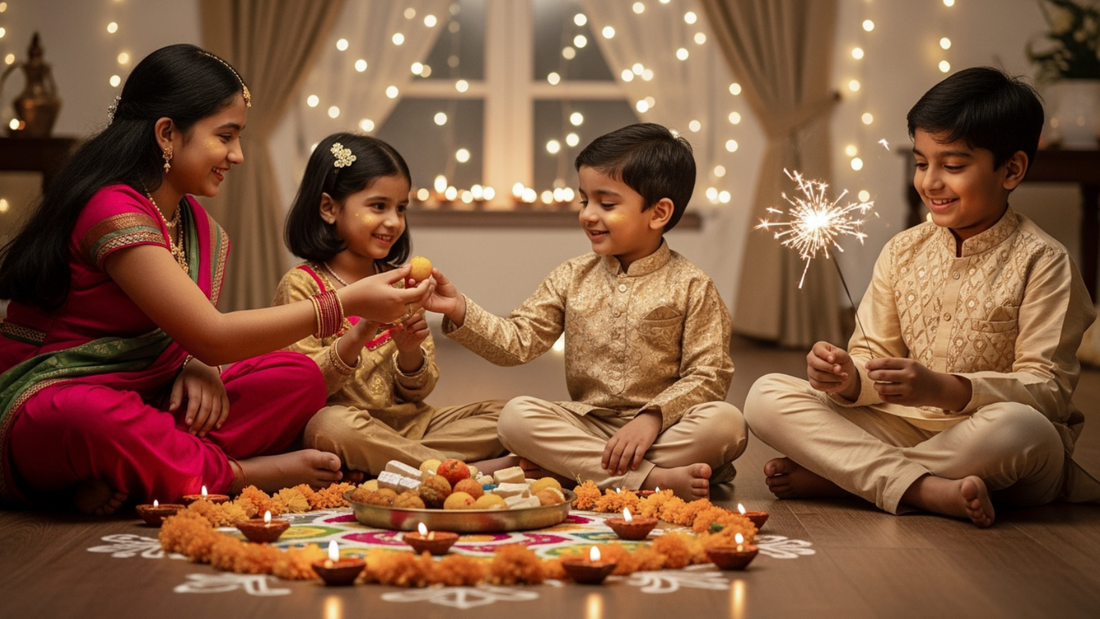
How Families Across India Celebrate Diwali: A Festival of Lights, Love & Healthy Traditions
Diwali isn’t just another festival; it’s India’s grand annual reset button.
Imagine streets dazzled up in fairy lights, homes smelling like cardamom and fried goodies, and grandmas pressing “beta, ek aur laddoo le lo” like it’s a national duty. From Mumbai’s buzzing high-rises to Kerala’s calm courtyards, families across the country light diyas, share sweets, and celebrate in their own style. Different rituals, same heartbeat: love, laughter, and enough mithai to power through five straight days of festivities.
Family: The Real Heartbeat of Diwali

Diwali is basically India’s five-day family festival marathon. North Indian families deck up homes for Lakshmi Puja, lining up diyas like twinkling soldiers to welcome prosperity. In the South, Deepavali starts with baths at sunrise (free spa day, anyone?) and new clothes that smell like fresh beginnings.
Meanwhile, Bengalis swap Diwali for Kali Puja, filling Kolkata with fierce goddess energy, and Gujaratis ring in their New Year with Bestu Varas. However different the customs, one constant remains: laddoos. Besan, boondhi, dates & nuts, dry fruits, each recipe guarded tighter than family heirlooms, passed down like edible treasures.
Diwali 2025: Health Meets Tradition
Here’s the tea (masala chai if you will): Indian families are rethinking how they celebrate. In 2025, the trend is clear—sweets are going guilt-free, mithai is going protein-rich, and moms are finally only approving “healthy” indulgence. Traditional recipes get a glow-up with jaggery, nuts, seeds, and plant protein. Because honestly, no one wants a sugar crash with festive rush!
Diwali 2025: Health Meets Tradition
Here’s the tea (masala chai if you will): Indian families are rethinking how they celebrate. In 2025, the trend is clear—sweets are going guilt-free, mithai is going protein-rich, and moms are finally only approving “healthy” indulgence. Traditional recipes get a glow-up with jaggery, nuts, seeds, and plant protein. Because honestly, no one wants a sugar crash with festive rush!

Origin Nutrition has always stood for clean nutrition made available and achievable for all. And now, as a limited edition Kit, our Laddoo - It - Yourself box has health and tradition combined. Parents love them because kids roll laddoos while learning about culture, and mainly, messy hands = festival fun. Plus, what you see is what you eat—no hidden preservatives sneaking around.
A Tour of Regional Celebrations

North India: The Classic Bollywood-Style Diwali
Picture homes lit like wedding venues, rangoli so detailed it should have an Instagram handle, and kitchens buzzing with sweets made from scratch. It’s part ritual, part art, part cardio.
West India: Where Diwali = Prosperity Goals
Gujarati and Marwari families treat Diwali as a financial new year. Lakshmi Puja doubles as a business blessing, and Mumbai’s high-rises turn into mini carnivals. Nuts and seeds sneak into sweets. Diwali here is as much about blessing your ledger as it is about blessing your taste buds.
South India: Rituals with a Side of Sweets
Temples sound, people rise before dawn, oil their hair, and step into fresh clothes for Deepavali. Karnataka families celebrate Bali Pratipada, while Kerala keeps it low-key with Sukrawar Deepavali. Kolam designs bloom outside homes, while laddoos and payasam sweeten family feasts. But louder than anything else. The home of Firecrackers is in the South.
East India: Art Meets Festivity
Bengalis blend Diwali with Kali Puja, adding a dramatic, artistic flair. Alpana patterns decorate floors, cultural shows light up evenings, and sweets like sandesh and rosogolla join the laddoo party. Here, it’s not just a celebration, it’s a performance.
Eco-Friendly, Future-Friendly Celebrations
Diwali lights up not just homes but also conversations about sustainability. Families are choosing biodegradable decorations, ditching plastic for clay diyas, and sourcing local, organic ingredients for their sweets. This is Diwali with a conscience—celebrating light while keeping the planet in mind.
Is Healthy the New Festive Tradition?
2025 families aren’t ditching sweets. They’re remixing them. Think jaggery laddoos packed with seeds and protein, snacks that fuel you instead of fluff you. It’s about indulging without the guilt-trip after. And yes, kids now get a front-row seat in the kitchen, turning mithai-making into a family bonding session (and low-key cooking class).
Rethinking sugar-heavy sweets is becoming the new “Diwali homework.” People want clean ingredients, hands-on fun, and enough nostalgia to keep traditions alive. Millennial parents especially love this—because hello, it’s wholesome and nutritious.
The Festival of Now, Rooted in Yesterday

So here we are: Diwali 2025. Families across India lighting diyas, rolling laddoos, sharing laughter, and starting new traditions that are healthier, greener, and just as joyful. Whether it’s a joint family making trays of laddoos or a nuclear family trying a DIY protein laddoo kit, the vibe is the same.
Love, laughter, and bonds.
Because at its heart, Diwali isn’t about the number of crackers you light or sweets you eat alone. It’s about togetherness, gratitude, and passing on stories (and sweets) to the next generation. And if those sweets just happen to be high-protein and low-sugar? Well, that’s just bonus fireworks!